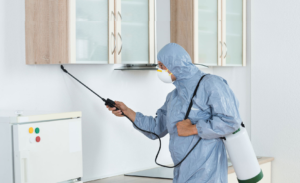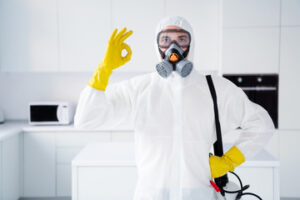Pest Control is the eradication of pests, usually rodents and insects, from buildings and gardens by exclusion, repellents, traps or physical removal. Chemicals may be used but should only be applied where necessary and with a low risk to health.
Accurate pest identification is the first step in any control program. This will help to determine underlying causes and select effective control methods. Visit Our Website to learn more.

A pest problem’s root causes can often be identified and reduced before treatment. This approach can be a cost-effective alternative to eliminating or suppressing a pest population.
Eliminating the food, water, and shelter that pests need can help prevent them from infesting a space. This includes storing food in tightly sealed containers and disposing of trash promptly. It also means not leaving pet food or water out overnight, fixing leaky plumbing, and regularly inspecting the landscape for sources of standing water (such as puddles).
Many pests invade spaces through small cracks and crevices, which can be closed using caulking. This can be done in homes, apartments, and commercial buildings. The same applies to the tiny gaps in roof eaves, which often become entry points for mice and other rodents. Regular inspections by residents and tenants can also help identify and seal such openings.
The simplest and most effective preventive measure is to remove or cover the pests’ access to food, water, and shelter. This can be accomplished by keeping shrubs and trees neatly trimmed so that they do not overhang structures, and by removing fallen branches and debris. It also involves keeping garbage cans and trash bins closed, and regularly removing waste to keep them clean.
Biological control uses the pest’s natural enemies (parasites, predators, pathogens) to reduce or eliminate it. In the case of insects, this may be achieved by releasing predatory wasps or birds that feed on pests, or by adding disease-causing bacteria or fungi to baits and traps.
Other methods, which use devices, machines, or other tools to deter or alter the pest’s environment, are called mechanical or physical controls. Examples include traps, screens, barriers, nets, fences, radiation, and electricity.
Chemical control usually uses pesticides in baits and traps or as spot sprays. Such chemicals should always be used sparingly, in small amounts, and with the proper safety precautions. They should never be sprayed around people or pets.
Integrated Pest Management is a strategy that combines preventive measures with controlled doses of pesticide, and monitoring to track the success of the plan. This can decrease reliance on and the risk associated with chemical pesticides, and can be an important component of maintaining safe working conditions for employees in food plant facilities.
Suppression
The purpose of suppression is to keep pest populations below damaging levels. This typically involves a combination of control tactics, including physical and biological controls.
Physical controls include traps, screens, barriers, fences and other devices that physically prevent pests from entering or exiting a field or garden. They can also be used to alter the environment in ways that make it unsuitable for the survival of pests, such as reducing the amount of available water or increasing the amount of sunlight.
Weather conditions, especially temperature and day length, directly affect pest activity and population size by influencing how fast a pest reproduces or how rapidly it consumes its host plant material. In addition, natural weather patterns such as rain, freezing temperatures and drought restrict the ability of a pest to thrive.
Birds, mammals, amphibians, reptiles, insects, nematodes and pathogens naturally suppress pest populations through predation, parasitism, herbivory or other mechanisms. Some of these organisms also feed on or kill plants that are not considered to be pests, and some pathogens target specific plant species and suppress their growth.
Biological pest control uses organisms that are natural enemies of a given pest to control its numbers, through predation, parasitism, or the triggering of disease processes. Generally, this approach is aimed at preventing pest problems from developing rather than at responding to an already existing problem. Two of the three approaches to biological control, conservation and augmentation, are practices that are available to home landscapers, while the third, classical or importation biological control, is restricted to scientific practitioners.
Many biological control agents have broad host ranges and can be effective against a variety of pest species. However, some are host-specific and only attack one or a few closely related pest species, such as the tachinid flies, trichogramma wasps, ichneumonid wasps and braconid mites. As a result, care is needed when selecting biological control agents to purchase and release. Similarly, augmentation biological control methods need to be carefully planned and implemented to ensure that the organisms selected will survive and establish a population capable of controlling the targeted pest.
Eradication
The goal of pest control is to prevent and eliminate pests from damaging crops, homes and other areas. A pest is anything that is unwanted in a human environment, whether they cause direct physical damage like cockroaches or mice or indirectly such as pollen from weeds or dandruff from your hair. They may frighten humans, such as spiders or earwigs, or they may bite or sting, and some can carry diseases, like fleas, mosquitoes and cluster flies. They may contaminate food, such as salmonella or listeria from rodents, or stain fabrics and carpeting, like beetles, ants and worms.
Eradication of pests is rare in outdoor situations where prevention and suppression are more common goals, but it is sometimes attempted. In such cases, eradication programs usually involve releasing natural enemies of the pest into an area in hopes they will prey on or otherwise control the population. This type of pest control is often referred to as biological pest control.
Chemicals are another form of pest control, and the most common type used around homes is insecticides. These are usually sold in the form of sprays that can be sprayed directly onto suspected infestations, but they can also be purchased in powders or bait forms to be placed where pests are most likely to be found. When using any type of pesticide, whether bought over the counter or by a professional, always read and follow all label instructions carefully. If you are concerned about the amount of chemicals being used in your home, seek out organic pesticides, which are made from plant materials and are generally safer than synthetic chemical pesticides.
Integrated pest management, or IPM, is an approach to pest control that seeks to minimize the use of pesticides by finding ways to deter pests from entering buildings or areas in the first place, and to use pesticides only when necessary. Simple steps, such as sealing cracks and crevices, storing food and trash properly, and keeping lawns and other landscaped areas neat and tidy can dramatically reduce the chances of unwanted pests entering structures.
Monitoring
Scouting and monitoring are vital parts of Integrated Pest Management, the process of solving pest problems in ways that minimize risk to people, property, and the environment. Detailed, ongoing monitoring provides the information you need to determine if and when control is needed. Using this information, you can select the most effective management method for each situation.
The goal of scouting is to check for, identify, and evaluate the number and severity of pests present in a field, building, or other site. In some situations, scouting may also involve monitoring the presence of indicator species that reflect environmental conditions and provide warnings of impending infestations, such as fungus-eating silverfish in collections storage areas or psocid flies in vegetable crops.
When a pest population exceeds an action threshold, it is time to take control measures. Thresholds are set based on pest-specific biology and ecology, as well as site or crop-specific factors. For example, in a vegetable field with high populations of Japanese beetles, an action threshold might include a certain number of beating sheet shakes (where each beat is counted and the counts are recorded) or a minimum of two insect traps set per site.
Other types of sites and crops require different approaches to sampling. For some pests, a progressive sampling system can be used, where a sample is considered definitely over or below the threshold after a specified number of beat sheet shakes, or by counting individual insects at each trap or glue board. However, the use of this type of monitoring may reduce the accuracy of pest counts if too few traps are placed at each station.
When scouting, a flashlight is important because many pests live or seek shelter in dark harborage places, such as under leaves, crevices, equipment, and foundations. An extendable mirror and a magnifier can help inspectors spot these areas during inspections. A pest log is also helpful for recording inspection results, especially when a treatment is taken. This will help record whether the action taken (such as sealing a crack) was successful or not. This log can also help identify points of entry and maintenance needs for the facility, reducing the likelihood of future pest invasions.

